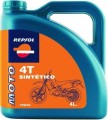-
Mineral. The name of this type is due to the fact that the oil is entirely of “fossil” origin - its components are hydrocarbons obtained during the distillation of oil. This type of oil appeared first and is still used today, however, it is gradually losing ground to synthetics and semi-synthetics. This is due to the fact that pure mineral oils are significantly inferior in characteristics to these two types. In particular, they do not tolerate both high and low temperatures - they can thicken and even freeze at -15...-20 ° C, and when they boil, they severely clog the engine. Oxidation of such oil occurs faster, which requires more frequent replacement. In addition, many modern engines put forward quite stringent requirements for the quality of fuels and lubricants, into which mineral oils simply do not fit. On the other hand, brands of this type are easy to produce and inexpensive.
—
Synthetics. Such oils are produced artificially, using chemical synthesis (hence the name). They appeared as a means of overcoming the shortcomings of mineral varieties and have proven themselves to be excellent in this role, because The technology for the production of synthetic oils makes it possible to create liquids with almost any characteristics - resistant to cold, not prone to oxidation, a certain viscosity, etc. On the other hand, this technology is quite complex and expensive, which consequently affects
...the price of the product.
- Semi-synthetic. Such brands of oil are mixtures of mineral and synthetic components and, accordingly, are a cross between the two types described above. They are much cheaper than purely synthetic oils, and although they are inferior in characteristics, they are in many ways superior to purely mineral products. Semi-synthetics are considered the best option for cases where oil consumption is high, but mineral varieties cannot be used - for example, if you often have to drive long distances in cold weather, or if the engine in a car for long trips has high demands on the quality of the lubricant.
— Flushing. Low-viscosity motor oils with a special package of detergent additives based on potent chemicals, used to maintain the internal components of the power unit in proper cleanliness, remove varnish deposits, accumulated dirt and slag, and neutralize acids formed in the engine. Flushing compounds are recommended for use when switching from one oil to another (based on base, viscosity or manufacturer), when purchasing a used car with an unknown service history, when there are visible carbon deposits under the valve cover, and under severe operating conditions of the engine.International standards that are claimed to be met in the specifications of this brand of oil. In modern oil brands, the following options may be found:
— API — standard developed in the USA by the American Petroleum Institute. It provides for two separate classifications — for gasoline (
API SG,
SH,
SJ,
SL,
SM,
SN,
SN RC,
SN Plus,
SN Plus RC,
SP,
SP RC,
SP Plus),
SQ and for diesel engines (
API CI-4,
CH-4,
CG-4,
CF,
CE,
CD); in the first case, the standard designation starts with the letter S (for example, API SL), in the second with C (for example, API CI-4). If the oil is suitable for both types of engines, a dual designation is used — for example, API SL/CI-4; in this case, the index of the type for which the oil is best suited is placed first (in our example it's gasoline). The standard also includes a classification for two-str
...oke engines — TA, TB, TC, TC+, TD.
— ACEA — standard used by the European Automobile Manufacturers Association, alternative to the American API. It includes three classes:
A/B — all oils developed before 2004 for different engine types. In fact, before 2004, there were two classes here — A for gasoline engines and B for diesel; then they were combined (A1/B1, A3/B3, A3/B4 and A5/B5). However, separate designations may still be used.
C — oils for all types of engines that comply with the Euro-4 environmental standard and are compatible with additional equipment such as catalysts and particulate filters. They include APEA C1, C2, C3, C4 and C5.
E — a separate class for diesel engines of heavy machinery, including special equipment. They are marked with APEA E4, E6, E7 and E9.
— JASO — developed by the Japanese Automobile Standards Association. It is one of the main modern standards for oils for gasoline motorcycle engines and within this purpose has two classes — F for two-stroke engines, namely FA, FB, FC, FD and M for four-stroke (subclass MA for wet clutch MA-1 and MA-2, MB for dry clutch). Also the new approval GLV-1 for ultra-efficient gasoline engines and hybrid power units.
— ILSAC — standard created jointly by the American and Japanese Automobile Manufacturers Associations. It is used for oils designed for passenger cars with gasoline engines. There are five categories of ILSAC (GF-2, GF-3, GF-4, GF-5, GF-6A, GF-6B, GF-7A, GF-7B), they are generally similar to certain API categories (see above), but differ in increased energy-saving requirements and emission limitations.
A list of specific oil standards recommended by the manufacturer for a particular engine is usually indicated in the official specifications of the vehicle. Note that many standards are interchangeable; information on compatibility (as well as a description of each individual category) can be found in specialized sources.
